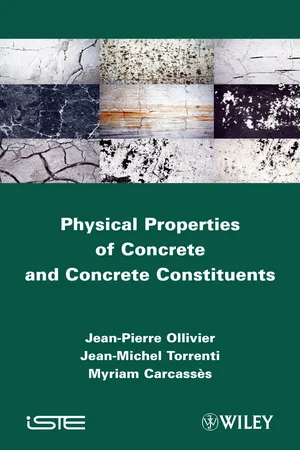Mathematics
Surface Area of a Solid
The surface area of a solid is the total area of all the surfaces of the solid. It is calculated by finding the sum of the areas of all the individual surfaces. In mathematics, surface area is an important concept used to measure the amount of material needed to cover the outside of a three-dimensional object.
Written by Perlego with AI-assistance
Related key terms
3 Key excerpts on "Surface Area of a Solid"
- eBook - ePub
Handbook of Analytical Techniques in Concrete Science and Technology
Principles, Techniques and Applications
- V.S. Ramachandran, J.J. Beaudoin(Authors)
- 2000(Publication Date)
- William Andrew(Publisher)
13Surface Area Measurements
Jan Skalny and Nataliya Hearn1.0 INTRODUCTION
Surface size and surface quality are two of the most important parameters of organic and inorganic solid materials. Surfaces of most solids, in tandem with other basic materials properties and environmental conditions, control to a large degree the rate of the relevant chemical and/or physicochemical reactions, thus the behavior of the material in real-world applications. The degree of this control relates to the surface area of the reacting material(s), aided by their reactivity —a quality depending on the crystallographic and other basic physical and chemical properties of the reacting solid.Specific surface area is defined as the surface area per unit of mass, typically expressed in square centimeters per gram (cm2 /g) or square meters per kilogram (m2 /kg). Specific surface area depends on the particle size, particle shape, and any imperfections or flaws present at the surface. Although not linearly related, knowledge of the surface area of a system of particles (and assuming that they are monosized, nonporous spheres) allows estimation of the average particle size of the powder and vice versa. The particle size of a solid body depends on the degree of natural or man-made growth or size-diminution. A larger particle will have a larger mass and volume per unit of surface area than a smaller particle. When a larger particle is subdivided into smaller particles by cutting, grinding, or other similar process, the total surface area will dramatically increase. For example, division of a 1 m3 cube into one micrometer cubed particles would increase the surface area from 6 m2 to 6 × 106 m2 , a millionfold increase.The Surface Area of a Solid also depends on the shape of the particle which, theoretically, can vary from a perfect sphere (minimum surface area-to-volume ratio) to a collection of atoms bonded along a one-dimensional chain (maximum surface area-to-volume ratio). The particle shape of real-world particles lies between these two extremes and so does the related surface area. Exact determination and classification of the three-dimensional shape of a particle is difficult; the best approximation is achieved by two-dimensional evaluation by means of computerized image analysis. - eBook - ePub
- John Bird(Author)
- 2021(Publication Date)
- Routledge(Publisher)
Chapter 28Volumes and surface areas of common solids
Why it is important to understand: Volumes and surface areas of common solidsThere are many practical applications where volumes and surface areas of common solids are required. Examples include determining capacities of oil, water, petrol and fish tanks, ventilation shafts and cooling towers, determining volumes of blocks of metal, ball-bearings, boilers and buoys, and calculating the cubic metres of concrete needed for a path. Finding the surface areas of loudspeaker diaphragms and lampshades provide further practical examples. Understanding these calculations is essential for the many practical applications in engineering, construction, architecture and science.At the end of this chapter you should be able to:- state the SI unit of volume
- calculate the volumes and surface areas of cuboids, cylinders, prisms, pyramids, cones and spheres
- calculate volumes and surface areas of frusta of pyramids and cones
- appreciate that volumes of similar bodies are proportional to the cubes of the corresponding linear dimensions
28.1 Introduction
The volume of any solid is a measure of the space occupied by the solid. Volume is measured in cubic units such asandmm 3,cm 3m 3.This chapter deals with finding volumes of common solids; in engineering it is often important to be able to calculate volume or capacity to estimate, say, the amount of liquid, such as water, oil or petrol, in different shaped containers.A prism is a solid with a constant cross-section and with two ends parallel. The shape of the end is used to describe the prism. For example, there are rectangular prisms (called cuboids), triangular prisms and circular prisms (called cylinders).On completing this chapter you will be able to calculate the volumes and surface areas of rectangular and other prisms, cylinders, pyramids, cones and spheres, together with frusta of pyramids and cones. Volumes of similar shapes are also considered. - Jean-Pierre Ollivier, Jean-Michel Toorenti, Myriam Carcasses(Authors)
- 2012(Publication Date)
- Wiley-ISTE(Publisher)
Chapter 3Specific Surface Area of Materials3.1. Definition
The specific surface area (or volume) of a material is the ratio expressed in m−1 between the outer surface S of the material and its volume. It can also be expressed in relation to its mass, m . This is known as the specific surface mass or specific surface area. It is this quantity, known asThe outer surface is the material surface in contact with the external environment, whether it is liquid or gas.Ss, that we will consider later and that we will denote, as per current practice, by the term specific surface area .It is usually expressed in m2 /kg or in cm2 /g.The specific surface area may be defined for granular materials and also for porous materials, which are studied in the second part of this book. For a granular material, the smaller the grains, the greater the ratio of outer surface to unit mass and so the larger the specific surface area. This quantity may therefore be used to account for the fineness of grains.The value of the specific surface area of a material generally depends on the method of measurement used, which must be specified. For example, we will thus speak of the Blaine or BET specific surface area, etc.3.1.1. The importance of this parameter: Portland cement hydration
Portland cement is in the form of a powder. By mixing it with water, we obtain a fluid cement paste. Cement grains react with water to form hydrate compounds, which structure themselves over time. The cement paste stiffens then the solid formed progressively hardens. Cement hydration may be described by the degree of hydration, which, in a given time, is equal to the percentage of hydrated cement. Figure 3.1 shows the progression of this degree of hydration over time in relation to the fineness of the cement.Figure 3.1.Influence of the specific surface area of cement on the degree of hydration. The black dots correspond to cement whose grains have an average size of 5 μm and the gray dots to cement whose average size is 30 μm (according to [BEN 99])
Learn about this page
Index pages curate the most relevant extracts from our library of academic textbooks. They’ve been created using an in-house natural language model (NLM), each adding context and meaning to key research topics.


